Fish

a fisherman loads dogfish
for English markets
For centuries, fish have attracted people to Middle Bank (Stellwagen Bank), as fisherman called the Bank before it was defined geographically by Captain Henry S. Stellwagen in 1854. The diversity of fishing techniques only partly mirrors the diversity of fish species; more than 130 species can be found on the Bank, some seasonal, others resident.
Fish are any aquatic animals with a backbone, fins for movement, and gills for extracting oxygen from water. This simplified definition may not always account for the great variety of fishes adapted to diverse environments; some fish carry water in their bodies to breathe terrestrially, while others have greatly reduced fins, etc. A careful look at the anatomy of individual species reveals a story of its habitat, habits and history.
Of the more than 20,000 known, living species of fish, all fall into at least three broad categories; the jawless fish (the Cyclostomes), including hagfish and lamprey; cartilaginous fish (the Chondrichthyes) including sharks and rays; and bony fish (the Osteichyes) including herring, cod, tuna, etc. Representatives of all three classes are found on the Bank.
Jawless Fish
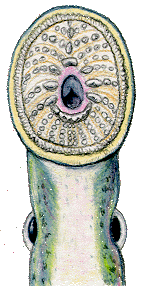
the face of the sea lamprey
The Cyclostomes are relatively primitive fishes that outwardly look like eels. They have cartilaginous skeletons, no jaws, skulls that hardly differ from the rest of the vertebrae, neither pectoral fins nor ribs. Two species live on the Bank, but are very rarely seen. Due to their food habits, neither will take hooks or are rarely hauled in by nets.
The sea lamprey, Petromyzon marinus is an active, voracious predator of other fish. It has a long (2 feet or 60 cm) sleek design headed by a flattened disk ringed with inward curving teeth. They chase and suck onto the bodies of a variety of fish (i.e.: cod, herring, basking sharks) and rasp through the scales and skin, consuming the bodily fluids of the host.
Sea lamprey are anadramous, running up rivers to spawn on gravel bottoms and die. The young spend a few years in freshwater mud habitats before moving on to sea.
The hagfish, Myxine glutinosa, spends long periods burrowed in clay or mud bottoms along
cold water currents. Lacking external eyes, four pairs of olfactory barbels probe the
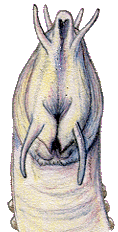
hagfish
currents for dead or dying fish. The tongue is modified into long pad of incurved teeth that everts to penetrate the body cavity of its food giving it access to the intestines and meat.
They are rarely seen, except when they have attacked hooked or netted fish. Surprisingly, there is a growing industry that harvests hagfish within the Gulf of Maine. Often using heavy buckets with a funneled opening strung together along a heavy line, they are mainly gathered for Asian markets to be used for the leather industry. Perhaps as a defense, it can pour gallons of mucous from glands on either side of the abdomen.
Cartilaginous Fish
Cartilaginous fish (the Chondricthyes) include sharks and skates. Their bodies are entirely supported by cartilage, lacking any true bones. They include species that are demersal (living at the bottom of the Bank) like the skates, and others that are pelagic (living in open waters) like many sharks. Studying the body design of a given species quickly reveals clues as to how the animal spends its life.
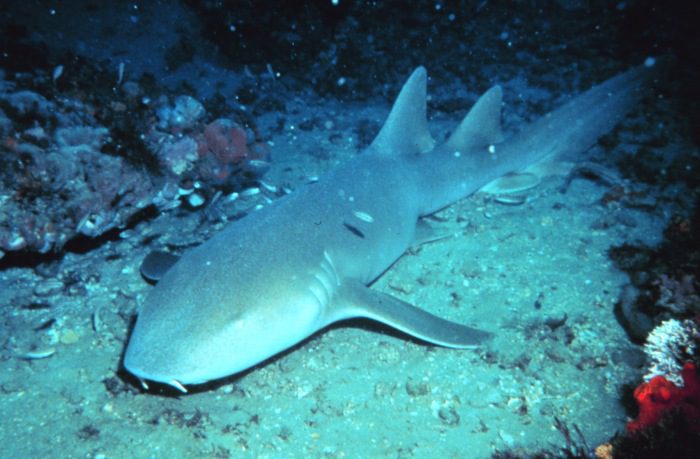
source: NOAA
Unlike many bony fishes, most sharks and skates are relatively slow breeders; producing a few large eggs or giving birth to a handful of live young (pups) in a season. Coupled with the fact that they are often top predators in their habitats, populations can quickly dwindle in the face of intense fishing. The need for conservation programs geared towards sharks especially, have increased recently. Relatively little is known about most cartilaginous fish on Stellwagen.
Species descriptions
The mackerel shark family includes a number of most impressive species that can be found sporadically on Stellwagen. Most are streamlined predators built for open-ocean cruising and speed. They include, in our area, the porbeagle, Lamna nasus; the great white, Carcharodon carcharias; and makos, Isurus oxyrinchus. They all are relatively rare or sporadic – at least, they are rarely spotted from the surface, but are sometimes caught by sports fishers. All give birth to a few, well-developed young.They tend to be opportunistic, taking prey, large and small.
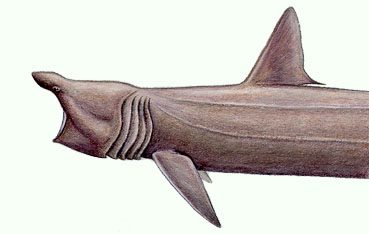
Basking Shark
The basking shark, Cetorhinus maximus, is probably the most commonly seen shark on Stellwagen Bank owing not to their absolute abundance but more to their habits. They are enormous animals, up to 30 feet (9 m) and weighing 8,000 pounds (3,600 kg). They are often found slowly cruising the surface with their enormous mouths agape and gills flared. As water passes into the mouth and out of the gills, the fine bristles of the modified gill rakers catch zooplankton. Little is known as to where they travel when local populations of plankton plummet with the darker days of fall and winter, nor about how and when they spawn.
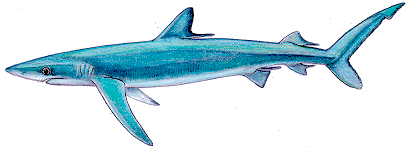
Streamlined shape of a blue shark
The blue shark, Prionace glauca, or the blue dog, is probably the second most commonly seen shark on the Bank. Their highly modified caudal and pectoral fins make them a quick, agile species. Rarely over seven feet, they feed on small and medium fish, squid, or just about anything else, including the carcasses of dead whales. Their teeth are highly serrated to process bite fulls of food. During whale-watches, they are sometimes found, on calm, warm days, cruising the surface with dorsal fin cutting the surface. Females give birth to 20-30 live young that develop within a placenta. Pups may be 1.5 (45 cm) feet at birth.

Hard spines at the base of each dorsal fin protect the spiny dogfish from larger predators
Spiny dogfish, Squalus acanthias, are by far the most numerous sharks on the Bank in summertime, despite the fact that few visitors encounter them. The best place to spot these 3 foot (1 m) fish is at a fishing port where draggers take advantage of their numbers, selling the fish to English markets for fish and chips. Most fishers on the Bank are well aware of their enormous schools as they pass, leaving a wake of torn and shredded fish in their wake. Voracious, they will take on fish as large as themselves, like cod or haddock, but will take almost anything, including combjellies.
Females bear small litters (4-10) of large pups (a foot long) every 18-22 months. Despite their low reproductive rate, dogfish have continued to hold their own in the face of new interest in them for commercial fisheries.
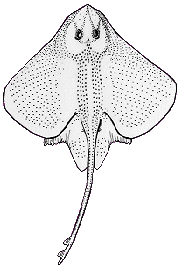
The highly modified body of the little skate
The little skate, Raja erinacea, like all skates, has a flattened body where the pectoral fins have merged into the length of the body. Usually, two dorsal fins sprout at the tip of the tail, which lacks any dangerous spine. The mouth and gills are on the undersurface, eyes on nostrils on top. Modified scales often create a thorny dorsal surface.
Skates spend most of their time stationary on the bottom, well camouflaged on sand or gravel (surrounding substrate may be thrown onto the back by undulations of the “wings”). They wait for small animals like sand lance, squid and crabs to pass within pouncing distance or actively grub through sand and gravel for clams and worms.
Like most cartilaginous fish, skates are fertilized internally with the males highly modified anal fins, or claspers. Females lay mermaids purses, or egg cases, throughout the year in relatively shallow water. Long spurs at each end of the purse act as an anchor to surrounding rocks or algae to keep embryoes from being swept away.
Young chew their way through the leathery purse after 5-7 months at about 4 inches (10 cm) long, with abdomens filled with yolk for sustenance.The wings of a skate can be
Mermaid’s purse
processed into sea scallops using a cylindrical cookie cutter. Recently, a number of species of skate have gained in popularity as table fish. Their relatively low birth and growth rate makes them vulnerable to sustained, high catches.

Our Work
Humpback Whale Research
Right Whale Research
Marine Animal Entanglement Response
Marine Geology Department
Water Quality Monitoring Program
Marine Fisheries Research
Seal Research
Shark Research
Marine Education
Interdisciplinary
Marine Debris and Plastics Program
Marine Policy Initiative
Cape Cod Climate Change Collaborative
Publications

